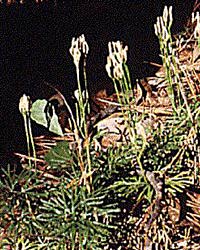Introduction to the Lycophyta
Club mosses and Scale trees


The lycophytes are a small and inconspicuous group of plants today, but in the Carboniferous some lycophytes were forest-forming trees more than 35 meters tall. Lycophytes are the oldest extant group of vascular plants, and dominated major habitats for 40 million years.
The club mosses (Lycopodiales) are usually evergreen, and have been used as Christmas decorations, though their flammable spores and increasing rarity has made this illegal in some states. Other lycophytes, such as Selaginella, may form extensive carpets in the understory of wet tropical forests.
The most significant feature of lycophytes are microphylls, a kind of leaf which has arisen and evolved independently from the leaves of other vascular plants. The microphyll has only a single unbranched strand of vascular tissue, or vein, whereas megaphylls, found in other plants with leaves, have multiple veins, usually branching one or more times within the leaf.
Click on the buttons below to learn more about the Lycophyta.
The University of Wisconsin offers images of lycophytes used in their General Botany courses.
Or peruse Dr. John Clayton's article on New Zealand native plants for use in aquaria, including Isoetes.


